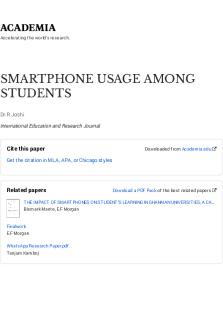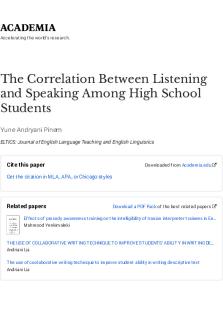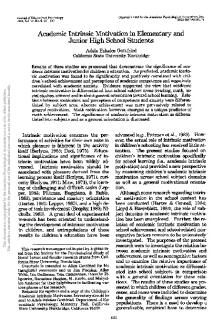The Correlation Between Listening and Speaking Among High School Students PDF

| Title | The Correlation Between Listening and Speaking Among High School Students |
|---|---|
| Author | Yune Andryani Pinem |
| Pages | 13 |
| File Size | 1.4 MB |
| File Type | |
| Total Downloads | 348 |
| Total Views | 909 |
Summary
ISSN : 2407-0742 THE CORRELATION BETWEEN LISTENING AND SPEAKING AMONG HIGH SCHOOL STUDENTS Yune Andryani Pinem STTKD Yogyakarta Abstract This research looks at listening as one factor that gives contribution toward speaking among high school students. The study attempts to reveal through data analys...
Description
Accelerat ing t he world's research.
The Correlation Between Listening and Speaking Among High School Students Yune Andryani Pinem ELTICS: Journal of English Language Teaching and English Linguistics
Cite this paper
Downloaded from Academia.edu
Get the citation in MLA, APA, or Chicago styles
Related papers
Download a PDF Pack of t he best relat ed papers
Effect s of prosody awareness t raining on t he int elligibilit y of Iranian int erpret er t rainees in En… Mahmood Yenkimaleki
T HE USE OF COLLABORAT IVE WRIT ING T ECHNIQUE T O IMPROVE ST UDENT S’ ABILIT Y IN WRIT ING DE… Andriani Lia T he use of coolaborat ive writ ing t echnique t o improve st udent abilit y in writ ing descript ive t ext Andriani Lia
ISSN : 2407-0742
THE CORRELATION BETWEEN LISTENING AND SPEAKING AMONG HIGH SCHOOL STUDENTS Yune Andryani Pinem STTKD Yogyakarta Abstract This research looks at listening as one factor that gives contribution toward speaking among high school students. The study attempts to reveal through data analysis, in the form of students‟ score from each variable that both have correlation. Further the objective of the study is also to find out the extent of influence contributed by listening toward speaking. The research applies library study and field study (instrument designing and test performing both for listening and speaking). The theory used for analysis deals with listening and speaking correlation from language learning review. The result of the study demonstrates that the correlation of listening as the independent variable with speaking as dependent variable is positive. It also proves that with a unit of program or treatment given toward listening class, there will be a significant improvement equals with 3.134 times from previous speaking score for the same sample. For the analysis of data, the extent of correlation between two varibales is shown as low. It indicates that even though listening do have positive correlation towarde speaking, it is not the only deminant factor to determine success in speaking. Background of Study To continue giving contribution toward the improvement of English language teaching, many researchers as well as teachers has been working hard to observe and expose this particular language through many perspectives. These perspectives may engage to the lingual aspects, intra-lingual aspect, teaching and learning method of the language. All is meant to help students and teachers to enhance their achievement in teaching learning session in the class. For almost six decades now, research and practice in English language teaching has identified the “four skill” – listening, speaking, reading and writing – as paramount importance (Brown, 1994:217). Richards and Renandya, however, elevate the idea that a large percentage of world‟s language learners study English in order to develop proficiency in speaking (Richards and Renandya, 2002:201). Therefore, it is no doubt that many of language teaching focuses are devoted to the highlighting of mastering English conversation. On the other hand, many language teachers hold listening as tithe most important skill of all so that its importance in language learning can hardly be underestimated. It is because through active listening, it is thought, students acquire vocabulary and syntax, as well as better pronunciation (Cross, 1992:244). English Education Study Program - PGRI UNIVERSITY OF YOGYAKARTA
Page 12
ISSN : 2407-0742
There are several reasons why people want to learn foreign languages. Those reasons are for advancement, target language community urge, specific purposes according to one‟s training, culture interest and some other simple reasons. Nevertheless, the greatest of all, people do it because it is on school curriculum. It‟s been years now since a trend of adapting listening to English language curriculum in formal education was started. In our country, we can find listening in English at school from elementary, middle school, high school until university level. Since 2004, the state government has incorporated listening to English subject in UN (Ujian Nasional – National Exam) for high school. This somehow gave spotlight to the listening and put it as something prominent like never before. School and teachers dedicate more attention and concentration to this subject in order to support their student to pass Ujian Nasional in English subject. Listening material became an overwhelming product as it was put into school curriculum. Yet, the lack of listening in linguistic will bring poor speaking skill because speaking and listening usually happen simultaneously. Literate people have a number of different abilities in linguistic. They possess language skills of speaking, writing, listening and reading. Very often, language users employ combination of those skills and for speech the combination will be speaking as productive skill and listening and understanding as receptive skill (Harmer, 1991:16-17). In order to analyze it in scientific way, this research is conducted. It is to find out whether listening has correlation with speaking in English language learning among high school students. If this analysis shows that listening does give influence to student‟s speaking, teaching who would like to develop class achievement in speaking may consider the result of this research as reference to do follow up.
Problem Statements 1.
Is there any significant correlation between listening in English learning with speaking among high school students?
2.
To what extent does listening give contribution to speaking skill in high school students?
Scope of Study A research has been conducted toward one class of high school students in Yogyakarta, which was choosen using random sampling technique, especially by observing their listening English Education Study Program - PGRI UNIVERSITY OF YOGYAKARTA
Page 13
ISSN : 2407-0742
score through a test given. This technique is applied with two basic principles: they are Equiprobability, which means that each population member in sampling has the same chance to be employed and Independence, which relates with fact that when one group of sampling is being choosen, it will not influence other group‟s chance (Sevilla and friends, 1993:163). Then another test was given to measure their speaking. Test given for both listening and speaking will be more to language function and comprehension. Finally, score from each skill in test was analyzed using product-moment correlation formula in order to find whether there is any significant correlation between both. For listening, instrument used is in the form of monologue thus the outcome of the test can be focused on students‟ individual competence. Objective of Study Objective of this study is to observe whether listening in English learning has any relation in determining speaking among high school students or not. If those two variables do have correlation, this study is also to find out to what extent listening give significant influence to students‟ speaking. Significant of Study This study is expected to give contribution of significance to: 1.
Teachers that have interest to develop their listening and speaking class achievement by giving concern to the result of this research.
2.
Students who take English Teaching as their minor, so that they can be thoughtful to this research result.
3.
Those who have special interest to observe how listening and speaking correlate.
Theoretical Approach This listening-speaking correlation research is inspired by some theories in language learning that shows strong relationship between those two variables. Among of them, there is Doff who verifies that one cannot develop speaking skills unless she also develops listening skills; to have a successful conversation, students must understand what is said to them (Doff, 1988:198). Listening is vital in the language classroom because it provided input for the learner, thus it is fundamental to speaking (Rost, 1994:141-142).
English Education Study Program - PGRI UNIVERSITY OF YOGYAKARTA
Page 14
ISSN : 2407-0742
Speaking Regarding to speaking, of all fours skills (listening, speaking, reading and writing), speaking seems intuitively the most important: people who know a language are referred to as „speakers” of that language, as if speaking included all other kinds of knowing and many if not most foreign language learners are primarily interested in learning to speak (Ur, 1996:120). Consequently, a large percentage of the world‟s language learner study English in order to develop proficiency in speaking (Richard and Renandya, 2002:201). Aural medium is one of factors affecting adult EFL learners‟ oral communication in the fact that when one person speaks and the other responds through attending by means of the listening process. During interaction, every speaker plays a double role – both as listener and as a speaker. So, speaking is closely related to or interwoven with listening, which is the basic mechanism through which the rules of language are internalized (Kang, 2002:205). In speaking, people put ideas into words, talking about perceptions, feeling and intention. They want other people to comprehend. They ask the listeners or receivers to get information. All theories reviews provided above again show that speaking activity is not merely an individual action. It requires audience or partner to listen and possibly to respond the speaker. In this manner, effective communication can be acquired as represented by depiction below: SENDER MESSAGE SOURCE
CHANNEL
RECEIVER
SIGNAL
DESTINATION
Figure 1: The Message Model
In the message model described above, the sender thinks up some information from source, and then transmits it through a signal. Next the receiver picks up the signal at the destination. The signal can be manifested in form of gesture, sound and of course in this case, language (McManis, Stollenwerk and Sheng, 1987:15).
Listening Concerning the central role of listening comprehension, which is nowadays highly accepted in foreign language acquisition process, listening is acknowledged to play an English Education Study Program - PGRI UNIVERSITY OF YOGYAKARTA
Page 15
ISSN : 2407-0742
extremely important position in the development of speaking ability (Kang, 2002:205). It is impossible to speak in a conversation if one does not listen; therefore, whenever communication takes place, of course, there is a speaker and a listener. This initiates the thought that an effective communication will always engage with oral and comprehension skills. As something that is assumed greater and greater importance in foreign language classroom (Nunan, 2002:238), the primacy of listening competence in interaction is evident to engage in any form of communication (Cross, 1992:244). It is necessary to understand and react to what has been said. Consequently, learners need to practice listening as well as engaging in interactional activities. Thus, even though that much of language teaching is devoted to instruction in mastering English conversation, numerous other forms of spoken language is also important to incorporate into a language course, especially in teaching listening comprehension (Brown, 1994:236-237). From a pragmatic view of language performance, listening and speaking are almost always closely interrelated. While it is possible to isolate some listening performance types, it is very difficult to isolate oral production tasks that do not directly involve the interaction of aural comprehension. Only in limited context of speaking (monologues, speeches, or telling story and reading a loud) can we assess oral language without the aural participation of an interlocutor (Brown, 2004:140). This affirmation again confirms the strong influence of listening to one‟s speaking skill. To emphasize this aspect is to understand that listening is often implied as part of speaking, as one won‟t be able to speak a language without also listening (Brown, 2004:119).
Collecting Data Data collecting takes the most important role for research performance. Therefore, it must be taken thoroughly and systematically. For the purpose of this research, data collecting is performed by conducting a test in a multiple choice form focusing on comprehension and language function in listening toward one class of high school students. The purpose of this test is to collect students‟ score. Then another test in speaking is given to measure students‟ competence in speaking. Score out of these tests is used as data to be further analyzed. Listening material is divided into three parts – In the pictures, Rooms and Christmas in Poland. Speaking test is performed in front of three raters by choosing one of topics provided including (1) describing picture, where the student can choose one of pictures English Education Study Program - PGRI UNIVERSITY OF YOGYAKARTA
Page 16
ISSN : 2407-0742
provided and tell everything they see in the picture, (2) describing your room, where the student can freely describe his/her own bedroom or (3) describing family customs in celebration to test out the speaking competence. Speaking scoring comprises two aspects of Accuracy and Fluency (Ur, 1996:135). Each aspect is determined into five levels of scoring from scale 1 as the lowest to scale 5 as the highest with total score 10 for Accuracy and Fluency. Accuracy scales are to consider whether there is little or no language produced from 1 point, poor vocabulary mistakes in basic grammar and may have very strong foreign accent for two points, adequate but not rich vocabulary and makes obvious grammar mistakes in slight foreign accent for 3 points, good range vocabulary and occasional grammar slips in slight foreign accent for 4 points and finally 5 points for wide vocabulary appropriately used with almost no grammar mistakes and native-like or slight foreign accent. While Fluency scales are to consider whether there is little or no communication for 1 point, very hesitant with brief utterances and sometimes difficult to understand for 2 points, gets ideas across but hesitantly and briefly for 3 points, effective communication in short turns for 4 points and lastly easy and effective communication used with long turns uses for 5 points.
Instrument Material used for listening test instrument has passed the validity and reliability test. There are four criteria for consideration in material selection. First, to be able to concentrate to students‟ individual skill, the test is designed in the form of monologue listening. Second, listening and speaking test material must be under the same type of describing things – pictures, rooms and customs. For each topic, numbers of questions in multiple choices forms are provided. There are five questions per topic with total 15 questions to answer from option A, B and C. Third, tense used in the test is in the form of present tense to make them parallel in tense. Finally, length of the test consist a range of 100 to 136 words. The purpose of instrument designing, selecting and validating for this correlation research is to determine orderly steps in validity measuring since validity of content is standard test which reflects the designing of test essence, topics and variant of measuring. Therefore, instrument of a research need to become a representative sample from measured validity of the content (Sevila and friends, 1993:179).
English Education Study Program - PGRI UNIVERSITY OF YOGYAKARTA
Page 17
ISSN : 2407-0742
Variable and Data There are two variables in this research. The first variable is students‟ listening skill which is independent variable and the second is students‟ speaking skill, which is dependent variable. Data needed is represented by students‟ score in listening and speaking out from test given. The researcher avoids using documented data because those data may have high tendency of irrelevance toward the objective of the research which focuses on individual competence. On the other hand, documented data may consist of accumulation score from each student.
Analyzing Data This is a correlation research that enables the making of estimation whether there is a relation between two variables. If two variables have strong relationship, correlation coefficient results closing to 1.00 (or -1.00). If two variables have no relationship at all, coefficient results closing to 0.00. The bigger relationship between two variables, estimation made according to this relationship is more precisely (Sumanto, 2002:109-110). Correlation coefficient is an instrument of statistic which can be used to compare measurement result of two distinctive variables in order to determine level of correlation between those two variables (Arikunto, 2006:270). To describe the strength of relationship between two variables, the most appropriate is using Pearson Product-Moment Correlation.
Data Calculation Pearson Product-Moment formula is used to calculate coefficient represented by the symbol of rxy. rxy
= NƩXY – (ƩX) (ƩY) √{NƩX2 – (ƩX)2} {NƩY2 – (ƩY)2}
In which: rxy
: correlation index
N
: Number of students
ƩX
: The sum of Listening score
ƩY
: The sum of Speaking score
ƩXY : The sum of X times Y
English Education Study Program - PGRI UNIVERSITY OF YOGYAKARTA
Page 18
ISSN : 2407-0742
Table 1 Variable 1 and Variable 2 No.
Students’ Listening Score (X)
Students’ Speaking Score (X)
Stdn 1. Stdn 2. Stdn 3. Stdn 4. Stdn 5. Stdn 6. Stdn 7. Stdn 8. Stdn 9. Stdn 10. Stdn 11. Stdn 12. Stdn 13. Stdn 14. Stdn 15. Stdn 16. Stdn 17.
6.00 8.00 5.33 6.67 4.00 4.00 7.33 6.00 4.00 4.67 5.33 6.67 4.67 5.33 4.00 6.00 6.67
6.33 8.00 4.33 4.33 6.33 4.33 2.67 5.33 4.67 5.00 3.00 6.67 5.00 3.00 2.67 5.67 4.67
Table 2 SPSS for windows result for variable listening (X) and variable (Y) Variable Listening (X) 17
17
0
0
Mean
5.5688
4.8235
Median
5.3300
4.6700
1.24598
1.49536
Minimum
4.00
2.67
Maximum
8.00
8.00
N
Valid
Variable Speaking (Y)
Missing
Std. Deviation
From data presented, it can be seen that with number of samples 17 for variable 1 – listening score, the value of mean which represents normal value if student listening score in this circumstance and sample of the research equals with 5.5688. Then, the value of median as the central value for this sampling equals with 5.33, with range equals with 4.00 and
English Education Study Program - PGRI UNIVERSITY OF YOGYAKARTA
Page 19
ISSN : 2407-0742
standard deviation equals with 1.24598. For this listening, students‟ minimal score is 4.00 and maximal score is 8. For variable 2 – speaking score, detail information obtained with number of sample equals with 17 including the value of mean as normal value of students‟ speaking score equals with 4.8235. Students‟ central value represents by median equals with 4.67. Standard deviation shows the value of 1.49536. Minimal score student obtained equals with 2.67 and maximal score equals with 8. As additional information, it can be seen that student number 7 has high score in listening yet low score in speaking. This student is considered as the outlier which normally appears in the result of a research. Next, to do further calculation, a helping table in neede...
Similar Free PDFs

SMARTPHONE USAGE AMONG STUDENTS
- 4 Pages
Popular Institutions
- Tinajero National High School - Annex
- Politeknik Caltex Riau
- Yokohama City University
- SGT University
- University of Al-Qadisiyah
- Divine Word College of Vigan
- Techniek College Rotterdam
- Universidade de Santiago
- Universiti Teknologi MARA Cawangan Johor Kampus Pasir Gudang
- Poltekkes Kemenkes Yogyakarta
- Baguio City National High School
- Colegio san marcos
- preparatoria uno
- Centro de Bachillerato Tecnológico Industrial y de Servicios No. 107
- Dalian Maritime University
- Quang Trung Secondary School
- Colegio Tecnológico en Informática
- Corporación Regional de Educación Superior
- Grupo CEDVA
- Dar Al Uloom University
- Centro de Estudios Preuniversitarios de la Universidad Nacional de Ingeniería
- 上智大学
- Aakash International School, Nuna Majara
- San Felipe Neri Catholic School
- Kang Chiao International School - New Taipei City
- Misamis Occidental National High School
- Institución Educativa Escuela Normal Juan Ladrilleros
- Kolehiyo ng Pantukan
- Batanes State College
- Instituto Continental
- Sekolah Menengah Kejuruan Kesehatan Kaltara (Tarakan)
- Colegio de La Inmaculada Concepcion - Cebu














